Pattern 1925 Khaki Web Equipment - Haversacks and Packs
As has been noted, W.E. Patt. '25 was designated as Web Equipment, Pattern 1919 in Canada. To distinguish it from the OTHER Patt. '19, we've tried to consistently refer to it as Pattern 1925. However, the title and text of Canadian Militia Order 500 are quoted as written, so you may well find both designations in the same paragraph.
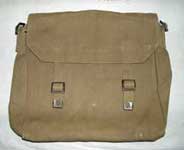

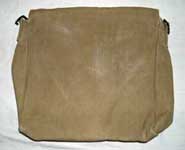 The Pattern 1925 Haversack is similar to the Patt. '19 Haversack, but all fittings on the rear have been deleted - this Haversack is designed to be suspended from the Braces only, and does not have provision to be worn on the back. Like the Patt. '14 and Patt. '19 Haversacks, it is approximately 9-inches tall by 11-inches wide, and is tapered in profile, deeper (4-inches) at the bottom than at the top (2-inches). This example is maker marked "M.E. Co." and dated 1927. From the Karkee Web Collection.
The Pattern 1925 Haversack is similar to the Patt. '19 Haversack, but all fittings on the rear have been deleted - this Haversack is designed to be suspended from the Braces only, and does not have provision to be worn on the back. Like the Patt. '14 and Patt. '19 Haversacks, it is approximately 9-inches tall by 11-inches wide, and is tapered in profile, deeper (4-inches) at the bottom than at the top (2-inches). This example is maker marked "M.E. Co." and dated 1927. From the Karkee Web Collection.
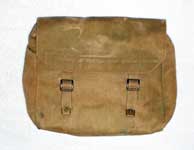


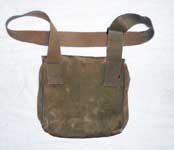 The Pattern 1925 Haversack was introduced in Canada as part of Web Equipment, Pattern 1919, under Militia Order 500, dated 28th September 1928. This example is Canadian marked, maker marked "M.E. Co." and dated 1928, which makes it part of the original Canadian issue. In itself, this makes it an interesting survivor. As Brig. Summers noted in Tangled Web, most of the Canadian equipment went to UK with Canadian troops early in WWII. There, it was returned to supply and replaced with W.E., Patt. 1937. This example, though, remained in Canada, where it was modified for use by the Canadian Women's Army Corps. The side chapes and 1-inch buckles were removed, and a shoulder strap fashioned from a 2-inch Pattern 1908 Brace. Once it was modified, this Haversack was issued to Sdt. Marcelle Mathieu. Her CWAC identification card is shown at right below. KW extend special thanks to Gian Rossignuolo for providing this provenance, and for permission to reproduce the ID card from her Collection. The Haversack itself was also formerly part of Gian's Collection; it is now in the Karkee Web Collection.
The Pattern 1925 Haversack was introduced in Canada as part of Web Equipment, Pattern 1919, under Militia Order 500, dated 28th September 1928. This example is Canadian marked, maker marked "M.E. Co." and dated 1928, which makes it part of the original Canadian issue. In itself, this makes it an interesting survivor. As Brig. Summers noted in Tangled Web, most of the Canadian equipment went to UK with Canadian troops early in WWII. There, it was returned to supply and replaced with W.E., Patt. 1937. This example, though, remained in Canada, where it was modified for use by the Canadian Women's Army Corps. The side chapes and 1-inch buckles were removed, and a shoulder strap fashioned from a 2-inch Pattern 1908 Brace. Once it was modified, this Haversack was issued to Sdt. Marcelle Mathieu. Her CWAC identification card is shown at right below. KW extend special thanks to Gian Rossignuolo for providing this provenance, and for permission to reproduce the ID card from her Collection. The Haversack itself was also formerly part of Gian's Collection; it is now in the Karkee Web Collection.
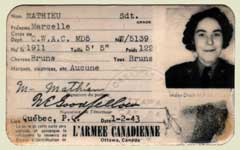
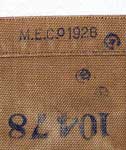 It's worth noting that the Haversack could have been used equally well as it was, simply by fitting a Patt. '25 or Patt. '37 Brace as a shoulder strap. The fact that the modification was judged to be worth the effort perhaps suggests that, at the time it was done, Patt. '37 was in short supply. On the other hand, it may have simply been that Canadian '19 and '08 web equipment was obsolete, available, and fit for purpose, as were sewing machines and the hands to use them. Waste not, want not, especially in time of war!
It's worth noting that the Haversack could have been used equally well as it was, simply by fitting a Patt. '25 or Patt. '37 Brace as a shoulder strap. The fact that the modification was judged to be worth the effort perhaps suggests that, at the time it was done, Patt. '37 was in short supply. On the other hand, it may have simply been that Canadian '19 and '08 web equipment was obsolete, available, and fit for purpose, as were sewing machines and the hands to use them. Waste not, want not, especially in time of war!

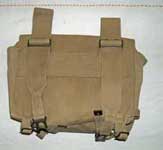 The Pattern 1925 Rucksack, Top Part, is the upper section of the two part system that replaced the Rucksack used with Web Equipment, Pattern 1919. There are two horizontal 3/4-inch straps on the face of the Rucksack, as shown in the picture far left. These are equipment straps, and are used to carry additional items such as axes, shovels, helmets, etc. The Rucksack, Top Part has integral 2-inch shoulder straps that loops over the shoulder on top of the Braces and connect to the buckles at the top of the Cartridge carriers. Each shoulder strap has a 3/4-inch side strap as well.These connect to buckles on the the bottom of the Rucksack, Top Part, when it is worn alone, and to buckles on the bottom of the Rucksack, Bottom Part, when both halves are worn. The side strap on the left is attached to the shoulder strap buckle, while one on the left is detachable. Instead of being sewn in place, it is attached to the shoulder strap buckle with a flat brass hook. This allows the Rucksack to be more easily removed. For a discussion of this Rucksack Supporting Strap (or Kicking Strap, as it was sometimes called in service), see the Web Equipment, Pattern 1925 (Blue-Grey) Belts and Straps page. This example is maker marked "M.E. Co." and dated 1927. From the Karkee Web Collection.
The Pattern 1925 Rucksack, Top Part, is the upper section of the two part system that replaced the Rucksack used with Web Equipment, Pattern 1919. There are two horizontal 3/4-inch straps on the face of the Rucksack, as shown in the picture far left. These are equipment straps, and are used to carry additional items such as axes, shovels, helmets, etc. The Rucksack, Top Part has integral 2-inch shoulder straps that loops over the shoulder on top of the Braces and connect to the buckles at the top of the Cartridge carriers. Each shoulder strap has a 3/4-inch side strap as well.These connect to buckles on the the bottom of the Rucksack, Top Part, when it is worn alone, and to buckles on the bottom of the Rucksack, Bottom Part, when both halves are worn. The side strap on the left is attached to the shoulder strap buckle, while one on the left is detachable. Instead of being sewn in place, it is attached to the shoulder strap buckle with a flat brass hook. This allows the Rucksack to be more easily removed. For a discussion of this Rucksack Supporting Strap (or Kicking Strap, as it was sometimes called in service), see the Web Equipment, Pattern 1925 (Blue-Grey) Belts and Straps page. This example is maker marked "M.E. Co." and dated 1927. From the Karkee Web Collection.
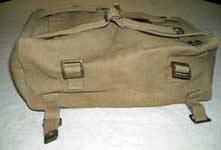 A view showing the bottom of the Rucksack, top part. In this view you can see the connections used to attach the Rucksack, bottom part.
A view showing the bottom of the Rucksack, top part. In this view you can see the connections used to attach the Rucksack, bottom part.
The Pattern 1925 Rucksack, Top Part, was introduced into Canada with the Web Equipment, Pattern 1919, under Militia Order 500, dated 28th September 1928.
The Pattern 1925 Rucksack, Bottom Part attaches to the Top Part to provide additional carrying capacity. Unlike the Rucksack, Top Part, it cannot be worn alone. The intention is that non-essential items of kit are carried in the Bottom Part. In troop movements, the Rucksack, Bottom Part, can be removed from the Top Part, closed, and carried by mechanised transport. Although the Bottom Part can be attached to the Top Part when closed, it is normally attached open. This allows items to be easily removed without disconnecting the two halves.
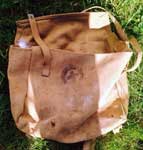
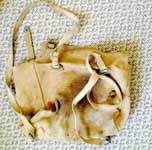 Of those with sets, none have a Bottom Part. The only contemporary photos we've seen are these two, sent to us by Joe Brunt. Whilst they aren't upo to KW's usual standards, we are grateful to Joe for being able to showe these. They show the front (far left) and back (near left).
Of those with sets, none have a Bottom Part. The only contemporary photos we've seen are these two, sent to us by Joe Brunt. Whilst they aren't upo to KW's usual standards, we are grateful to Joe for being able to showe these. They show the front (far left) and back (near left).
Ignore the ¾ inch straps, which have been added as rudimentary shoulder straps. They are not part of the Rucksack.
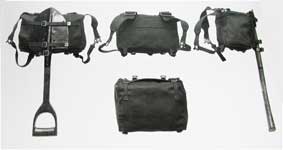
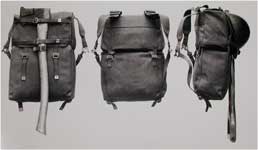 These are official M.E.Co. photographs, which shows Top and Bottom Parts assembled. The axe and shovel replicate the drawings in Patent 177,380 of 1921, though more usually these horizontal straps held the steel helmet. Note the short strap and buckle, stitched to the Top Part, which secured round the helve / handle. This strap was not fitted on any Top Part so far seen.
These are official M.E.Co. photographs, which shows Top and Bottom Parts assembled. The axe and shovel replicate the drawings in Patent 177,380 of 1921, though more usually these horizontal straps held the steel helmet. Note the short strap and buckle, stitched to the Top Part, which secured round the helve / handle. This strap was not fitted on any Top Part so far seen.
The Pattern 1925 Rucksack, Bottom Part, was introduced into Canada with the Web Equipment, Pattern 1919, under Militia Order 500, dated 28th September 1928. The Pattern Year is, of course, erroneous. See the Introduction to the W.E. Pattern 1925 Section for a discussion on Canada's nomenclature for this pattern.